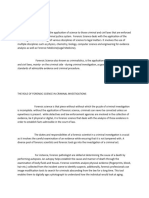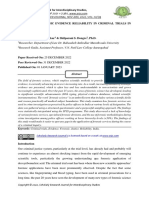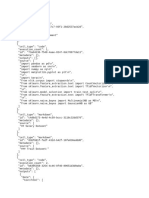Biometrics in Forensic Identification Ap
Uploaded by
ShallyBiometrics in Forensic Identification Ap
Uploaded by
ShallyJournal of Forensic Medicine Saini and Kapoor, J Forens Med 2016, 1:2
http://dx.doi.org/10.4172/2472-1026 .1000108
Review Article Open Access
Biometrics in Forensic Identification: Applications and Challenges
Monika Saini* and Anup Kumar Kapoor
University of Delhi, Delhi, India
*Corresponding author: Monika Saini, University of Delhi, Delhi, India, Tel: 91-8130634711; E-mail: mini.1901@yahoo.com
Rec date: March 04, 2016; Acc date: May 19, 2016; Pub date: May 25, 2016
Copyright: © 2016 Saini M, et al. This is an open-access article distributed under the terms of the Creative Commons Attribution License, which permits unrestricted
use, distribution, and reproduction in any medium, provided the original author and source are credited.
Abstract
Accurate and efficient identification have become a vital requirement for forensic application due to diversities of
criminal activities. A recent advancement in biometric technology which is equipped with computational intelligence
techniques is replacing manual identification approaches in forensic science. Biometrics is a fundamental verification
mechanism that identifies individuals on the basis of their physiological and behavioral features. These biometric
expansions are easily observable in different forensic identification areas, e.g. face, fingerprint, iris, voice,
handwriting, etc. The effectiveness of biometrics system lies in different recognition processes which include feature
extraction, feature robustness and feature matching. The emergence of forensic biometrics covers a wide range of
applications for physical and cybercrime detection. Forensic Biometrics also overcomes the loopholes of traditional
identification system that were based on personal probabilities. It is considered as a fundamental shift in the way
criminals are detected. The present study describes the contribution and limitations of biometric science in the field
of forensic identification.
Keywords: Forensic science; Manual identiication; Biometrics; Limitations of Forensic Science in Criminal
Computational intelligence; Forensic biometrics; Criminal Identiication
identiication
Today, forensic science is facing a number of challenges in the
Crime and Forensic Science: A Linkage process of crime detection. hese challenges are as follows:
Insuiciency of available evidences: he presence of small piece of
he extent of reported crime incidents is increasing perilously day
physical or biological evidences that are hidden in a chaotic crime
by day. Crime is an intentional act or omission in violation of criminal
scene is a type of challenge that is commonly faced by crime
law, committed without defense or justiication, and sanctioned by the
investigator. Examples include a small portion of ingerprints, ear
state as a felony or misdemeanor. It is a deviation from social norms
print, shoe prints, fraction of dental features, concealed handwriting
administered by law and its type of costs adversely afects everyone in a
and unnoticeable paint scratch.
society to some extent. herefore, there is an acute need of accurate
and eicient crime detection that may assist in ighting wide verities of Identity concealment: he majority of criminals devote their
criminal activities. knowledge in covering or disguising their activities to conceal their
true origin. herefore, sometimes the human forensic expertise
Forensics techniques are being used in the investigation of criminal
remains ineicient in studying the speciic properties of the evidences.
activities as traditional methods. Forensic science begins with the
For example: Skilled forgeries.
efective identiication, documentation (collection of notes,
photographs, sketching and videos of crime scene), collection and Time consumption: he traditional forensic methods of criminal
preservation of physical (covers items of non-living origin such as identiication and veriication are very time consuming process. he
ingerprints, footprints, ibers, paint, tire or shoe impression and analysis and comparison of crime data against a volume of suspected
weapons) and biological evidence (originates from a living source and data is a tedious process.
includes DNA, other bodily luids, hair, skin and bone material) at the
Lack of standardization: Crime detection is based on the
crime scene. he evidence is then subjected to scientiic analysis in the
standardized investigative procedures. Due to the limitations of
forensic laboratory and the results of the examinations yield forensic
cognitive abilities of human forensic expertise in the case of large
evidence for consideration by court. Ultimately, the evidence will be
volume data, lack of standardization poses a great challenge.
presented as proof that a crime was committed and will prove the
identiication of the criminal [1]. he conventional forensic approach of crime investigation is time-
consuming resulting in a lot of delay and oten ineicient leading to
A number of methods like forensic anthropometry, forensic
high expenditure. So there is a need to automize the crime
dactyloscopy, forensic odontology and forensic document examination
investigation procedure that can give accurate and reliable crime
are major tools of criminal identiication that exist from the end of
detection results.
19th century. hese methods use physical characteristics for the
identiication or individualization of a criminal.
J Forens Med Volume 1 • Issue 2 • 1000108
ISSN:2472-1026 JFM an open access journal
Citation: Saini M, Kapoor AK (2016) Biometrics in Forensic Identification: Applications and Challenges. J Forens Med 1: 108. doi:
10.4172/2472-1026 .1000108
Page 2 of 6
Biometrics: A Strong Alternative for Crime Detection 6. Acceptability: Individuals that will access the biometric device
should be willing to present their biometric traits to the system.
Biometrics is one of the most fascinating ways to solve the crime. It
is an automated way to establish the identity of a person on the basis of 7. Circumvention: It refers to the ease with which the trait of a
his or her physical (inger print, face, hand/inger geometry, iris, retina, person can be imitated or copied by using artefacts (e.g. fake ingers in
ear, etc.) and behavioral characteristics (signature, voice, gait, odor, case of physical and mimicry in case of behavioural traits). he
etc.). Biometric technology makes a contribution to crime detection by biometric system should be immune to the circumvention.
associating the traces to the persons stored in the database, ranking the
identity of persons and selecting subdivision of persons from which Identiication and Veriication
the trace may originate.
Biometrics system can be classiied into two main categories on the
A biometric system is a pattern recognition device that acquires basis of application mode: Veriication and Identiication
physical or behavioral data from an individual, extracts a salient
feature set from the data, compares this feature set against the features In the identiication mode, the biometric system identiies an
set stored in the database and provides the result of the comparison. individual by searching the templates of all the individuals whose
herefore, a biometric system is composed of four modules [2]: identiication details are stored in the database. In this process, the
system conducts a one to many comparison to prove the identity of a
Sensor module: his component acquires the raw biometric data of person.
an individual by scanning and reading. For example, In case of
ingerprint recognition, an optical ingerprint sensor may be used to In the veriication mode, the biometrics information of an
image the ridge pattern of the ingertip. he quality of raw data is individual, who claims certain identity, is compared with his own
inluenced by the scanning or camera device that is used. biometric template stored in the system database. his is also referred
as one to one comparison.
Quality assessment and feature extraction module: For further
processing, the quality of the acquired raw data is irst assessed. he Biometric technologies ind a place in crime detection in a number
raw data is subjected to signal enhancement algorithm to improve its of ways: (a) he modules and techniques of biometrics help in
quality. his data is then processed and a set of salient features analyzing the evidence by overcoming the limitations of human
extracted to represent the underlying trait. his feature set is stored in cognitive abilities and thus increases eiciency and efectiveness of
the database and is referred as template. For example, the position and investigation (b) hese methods provide scientiic basis (by applying
orientation of minutia in a ingerprint image is extracted by the feature techniques of computer science, applied mathematics and statistics)
extraction module in inger print biometric system. and standardization for crime investigation procedure by analyzing
huge bulk of data which are not humanly possible (c) hese techniques
Matching and decision making module: In this module, the provide the advantages of visualizing and documenting the result of
extracted templates are then matched against the stored templates and analysis.
a matching score is given. On the basis of the matching score, the
identity of a person is validated or ranked. Development of Biometric technology
System database module: his module acts as storage of biometric
he implementation of automated ingerprint identiication system
system. During the enrolment process, the template extracted from
(AFIS) in 1960 established the irst application of biometrics where the
raw biometric data is stored in the database along with some
automation of identity veriication was based on the ten print cards. In
biographic information (such as name, address, etc.) of the user.
1980’s forensic DNA proiling was discovered where identity
veriication was done on the basis of DNA reference material using a
Characteristics of Biometrics computerized DNA database.
he selection of each biometric trait depends on the variety of issues As a consequence of the development of mobile telecommunication
besides its matching criteria. Jain et al. [2] have identiied seven factors and camera surveillance technologies (CCTV), speaker, face and gait
that determine the suitability of a physical or behavioural trait to be recognition became important biometric tools in the 1990. Ater 2001
used in biometric application. the interest rose for sot biometric modalities such as body
1. Universality: Every individual who is using the biometric measurements (height, width, weight) and proportions, gender, hair,
application must possess the trait. skin colour and clothing characteristics. his interest was mainly
motivated by the possibility of capturing these features in unconstraint
2. Uniqueness: he trait must show a suicient diference across environments [3].
individuals comprising the population.
3. Permanence: he given biometric trait should not change Data Acquisition in Biometric System
signiicantly over a period of time.
In the forensic context, a test sample obtained from a crime scene is
4. Measurability: he trait should be easy to get and digitize and referred as crime scene sample, traces material and questioned item
should not cause inconvenience to the individual. It should also be whereas the reference sample that is compared against the crime scene
amenable to process further in order to extract features from the sample is named controlled material or known item. Some of the trace
acquired data. samples (biological traces, inger marks, earmarks, bite marks and lip
marks) are collected physically while others are acquired digitally (face,
5. Performance: he recognition accuracy and the resources
voice, body measurements and gait).
acquired to achieve that accuracy must meet the constraints imposed
by the individual.
J Forens Med Volume 1 • Issue 2 • 1000108
ISSN:2472-1026 JFM an open access journal
Citation: Saini M, Kapoor AK (2016) Biometrics in Forensic Identification: Applications and Challenges. J Forens Med 1: 108. doi:
10.4172/2472-1026 .1000108
Page 3 of 6
he particular biometric trait needs to be unique, distinctive and State Police have found facial recognition to be very beneicial in
robust to the forensic conditions. herefore, inger-marks and attempting to identify unknown subjects who commit crimes of
biological traces are searched in priority on a crime scene. he identity thet and fraud [4].
performance of a biometric system is largely inluence by the quality of
In October, 2001, Fresno Yosemite International (FYI) airport in
input sample conditioned by the acquisition and environmental
California deployed Viisage's face recognition technology for airport
conditions of a crime scene.
security purposes. he system is designed to alert FYl's airport public
safety oicers whenever an individual matching the appearance of a
Applications of Biometrics in Forensic Investigation known terrorist suspect enters the airport's security checkpoint [5].
UK-based company NEC IT Solutions, which also specializes in
Fingerprint biometrics
identiication of terrorists and criminals, has created a system that
Fingerprints have been used in criminal investigations as a means of analyzes the faces of potential customers as they enter shops. he
identiication for centuries. It is one of the most important tools of system then checks this information against a database with celebrities
crime detection because of their robustness and uniqueness. and valued customers - to help stores identify potential big spenders
[6].
A ingerprint is the pattern of friction ridges and valleys on the
surface of a ingertip. In order to match a print, a ingerprint NEC’s NeoFace Reveal is a latent face workstation that reduces
technician digitalizes or scans the print obtained at a crime scene and investigation time for cases that contain facial video evidence, thus
computer algorithms of a biometric system locate all the unique reducing case load for investigators. Another advantage of NeoFace
minutia and ridge points of a questioned print. hese unique feature Reveal is its rapid processing of facial evidence coupled with its ability
sets are then matched against a stored ingerprint database. to generate persons of interest list investigation immediately ater the
crime has taken place.
he Integrated Automated Fingerprint Identiication
System (IAFIS) is a national automated ingerprint identiication and his advantage allows investigators identify a suspect prior to the
criminal history system maintained by the Federal Bureau of suspect evading capture by leaving the local community, state or
Investigation (FBI). IAFIS provides automated ingerprint search country [7].
capabilities, latent searching capability, electronic image storage, and
electronic exchange of ingerprints and responses. DNA biometrics
IAFIS houses the ingerprints and criminal histories of 70 million Deoxyribonucleic acid (DNA), a chain of nucleotides contained in
subjects in the criminal master ile, 31 million civil prints and the nucleus of our cells, can be used as a biometric tool to classify and
ingerprints from 73,000 known and suspected terrorists processed by guide the identiication of unknown individuals or biological samples
the U.S. or by international law enforcement agencies. let by them. he analysis of the DNA molecule in forensic science is
he average response time for an electronic criminal ingerprint called forensic DNA proiling [8].
submission is about 27 min, while electronic civil submissions are he use of DNA (Deoxyribose nucleic acid) in crime investigation
processed within an hour and 12 min. IAFIS processed more than 61 has grown in recent years. It helped law enforcement in a great way to
million ten-print submissions during Fiscal Year 2010. identify the criminals and solve diicult crimes.
In September 2014, the FBI announced that its Next Generation DNA of a person can be located throughout his\her entire body.
Identiication system was at full operational capability and efectively DNA is present in a number of bodily materials such as blood, saliva,
replaced IAFIS. hair, teeth, mucus and semen. DNA evidence can be easily found at a
he Ministry of Home Afairs, Government of India is also going to crime scene.
set up a national ingerprint database of 28 lakh convicts to enable DNA biometrics uses genetic proiling which is also referred as
speedy identiication of ofenders and expedite ongoing probes. genetic ingerprinting. In this process the DNA is irst extracted from
the sample and then segmented into variable number of tandem
Face biometrics repeats (VNTR’s). hese segments are then compared against the
stored database.
Biometric face recognition technology plays an important role in
law enforcement. Facial recognition is a computer based system that he federal Bureau of Investigation (FBI) in 1990 launched a
automatically identiies a person on the basis of image or video which national DNA database, CODIS (Combined DNA Index System)
is then matched to the facial image stored in a facial biometric which can be used to identify possible suspects by matching DNA
database. proiles. his database is assisting in forensic crime laboratories at the
local, state and federal levels to identify criminals and solve crimes.
In 2012 the FBI launched the Interstate Photo System Facial
Recognition Pilot project in three states, and as of June 2014 the system
was fully deployed. It allows participating law enforcement Palmprint biometrics
organizations to use face recognition to search against more than 15 he palms of the human hands also contain unique pattern of valley
million mug shots, returning a ranked list of potential matches by and ridges. he area of palm is much larger than the area of a inger,
using algorithms to search for a match. and as a result, palmprints are expected to be even more distinctive
he system matches the photo taken at the booking station or from than ingerprints [9]. Palmprint provides crime investigators an
a crime scene with mug shots in the NGI (Next Generation Database) important additional investigative tool. Around 30% of time palm
database that have a high probability of being a match. he Michigan prints are found at a crime scene.
J Forens Med Volume 1 • Issue 2 • 1000108
ISSN:2472-1026 JFM an open access journal
Citation: Saini M, Kapoor AK (2016) Biometrics in Forensic Identification: Applications and Challenges. J Forens Med 1: 108. doi:
10.4172/2472-1026 .1000108
Page 4 of 6
In May 2013, FBI launched a Palmprint database which is assisting Recognition based on gait is one of the newer biometrics and needs to
crime investigators in positive identiication of criminals. be researched in detail.
NEC and PRINTRAK companies have developed several palmprint Gait is a behavioural biometric and inluenced by a number of
identiication systems for criminal application. In these systems high factors such as body weight, walking surface, footwear, nature of
resolution palmprint images are captured and then detailed features clothing, etc.
like minutiae are extracted for matching the latent prints [10].
Keystroke biometrics
Iris biometrics
It is believed that each individual types on a keyboard in a unique
Iris recognition is the automated process of recognizing a person on way. his biometric is also not very distinctive and unique in
the basis of unique pattern of iris. he iris is the annular region of the identiication but assists in recognition of an individual by ofering
eye bounded by the pupil and sclera (white part of the eye). In the iris suicient discriminatory information.
recognition, digital templates of iris are compared against the stored
Keystroke pattern is also inluenced by emotional state, keyboard
templates.
position, type of keyboard etc. Advantage of using keystroke behaviour
he federal Bureau of Investigation (FBI) planned a database for for recognition is that it can be easily observed unobtrusively as that
searching iris scans nationwide to more quickly track criminals. person is keying the information.
he UK government in 2002 began IRIS (Iris recognition his biometric permits continuous veriication” of an individual’s
immigration system) program which enables more than a million identity over a session ater the person logs in using a stronger
registered travelers to enter the country via several British airports biometric such as ingerprint or iris.
using only automatic iris recognition for identiication, in lieu of
passport presentation or any other means of asserting an identity. Odour biometrics
Iris recognition system are also used in providing positive identity Each object spreads around an odor that is characteristic of its
assurance for larger transactions at live teller stations which lower the chemical composition and this could be used for distinguishing
risk of losses due to identity thet. various objects. his would be done with an array of chemical sensors,
each sensitive to a certain group of compounds. Deodorants and
Voice biometrics perfumes could lower the distinctiveness [13].
Voice biometrics deals with the identiication of a speaker from the In addition to these biometric technologies, a number of other
characteristics of his\her voice. It is oten used when voice is the only biometric modalities such as ear, dental, hand geometry and
available trait for identiication, e.g. telephoned bomb threat, demand handwriting biometrics are also used by law enforcement agencies and
of money in kidnapping cases etc. It has two approaches: Text government sectors to address various identity issues and criminal
dependent (recognition based on the ixed predetermined phrases) and activities. In some criminal cases, it is also important to identify the
text independent (recognition is independent of what a person is ethnicity to which the criminal belongs.
speaking).
A research has also been done on ethnicity estimation from
AGNITIO’s voice ID technology is a voice biometric tool designed handwriting patterns [14]. hese biometric traits are not very
for criminal identiication experts and scientiic police to perform distinctive and unique so they are not used in large scale identiication.
speaker veriication. It is used in court in more than 35 countries hese technologies assist other major biometric traits to improve the
worldwide. he traits measured in a given voice sample are biological, performance of the identiication.
expressed through the actual sound of a suspect’s voice rather than the
It is obvious that no single biometric is the "ultimate" recognition
shape of the words they are saying [11].
tool and the choice depends on the application. A brief comparison of
Russia’s Speech Technology Center, which operates under the name the above techniques is provided in Table 1 [15].
SpeechPro in the United States, has invented VoiceGrid Nation, a
system that uses advanced algorithms to match identities to voices. Limitations of Biometric Systems
It enables authorities to build up a huge database containing up to Due to diferent positioning on the acquiring sensor, imperfect
several million voices of known criminals, persons of interest, or imaging conditions, environmental changes, deformations, noise and
people on a watch list. It takes just ive seconds to scan through 10,000 bad user's interaction with the sensor, it is impossible that two samples
voices, and so long as the recording is decent quality and more than 15 of the same biometric characteristic, acquired in diferent sessions,
seconds in length. his technique has already been deployed across exactly coincide.
Mexico [12].
For this reason a biometric matching systems' response is typically a
matching score s (normally a single number) that quantiies the
New Emerging Biometric Technologies
similarity between the input and the database template
representations. he higher the score, the more are the chances that
Gait biometrics two samples will coincide.
Gait refers to the peculiar way one walks and it is a complex spatio-
temporal biometrics. It can be used to identify a person from a distant
point. herefore, this biometric is appropriate in surveillance scenario
where the identity of a person can be surreptitiously established.
J Forens Med Volume 1 • Issue 2 • 1000108
ISSN:2472-1026 JFM an open access journal
Citation: Saini M, Kapoor AK (2016) Biometrics in Forensic Identification: Applications and Challenges. J Forens Med 1: 108. doi:
10.4172/2472-1026 .1000108
Page 5 of 6
Biometric
Universality Distinctiveness Permanence Collectability Performance Acceptability Circumvention
Characteristic
Fingerprint M H H M H M M
Face H L M H L H H
DNA H H H L H L L
Palmprint M H H M H M M
Iris H H H M H L L
Voice M L L M L H H
Gait M L L H L H M
Keystroke L L L M L M M
Odour H H H L L M M
Table 1: A Comparison of various biometric technologies
A similarity score s is compared with an acceptance threshold t and characteristic (ROC) curve that plots the FMR against FNMR at
if s is greater than or equal to t compared samples belong to a same diferent thresholds [16] (Figure 2).
person. Pairs of biometric samples generating scores lower than t
belongs to a diferent person. he distribution of scores generated from
pairs of samples from diferent persons is called an impostor
distribution, and the score distribution generated from pairs of
samples of the same person is called a genuine distribution [16] (Figure
1).
Figure 2: Receiver operating characteristic curve.
here are two other recognition error rates that can be also used and
they are: failure to capture (FTC) and failure to enroll (FTE). FTC
denotes the percentage of times the biometric device fails to
automatically capture a sample when presented with a biometric
Figure 1: Biometric system error rates. characteristic. his usually happens when system deals with a signal of
insuicient quality. he FTE rate denotes the percentage of times users
cannot enroll in the recognition system.
he main system errors are usually measured in terms of
FNMR (false non-match rate) mistaking two biometrics Multimodal Biometrics in Crime Detection
measurements from the same person to be from two diferent persons;
Multimodal biometrics allows the integration of two or more than
FMR (false match rate) mistaking biometric measurement from two biometric recognition and veriication systems in order to enhance
two diferent persons to be from the same person. performance requirements of identiication. hese systems are more
FNMR and FMR are basically functions of the system threshold t: if reliable due to the presence of multiple biometric evidences. A
the system's designers decrease t to make the system more tolerant to multimodal system could be, for instance, a combination of ingerprint
input variations and noise, FMR increases. On the other hand, if they veriication, face recognition, voice veriication and smart-card or any
raise t to make the system more secure, FNMR increases accordingly other combination of biometrics. his enhanced structure takes
[1]. FMR and FNMR are brought together in a receiver operating advantage of the proiciency of each individual biometric and can be
used to overcome some of the limitations of a single biometric.
J Forens Med Volume 1 • Issue 2 • 1000108
ISSN:2472-1026 JFM an open access journal
Citation: Saini M, Kapoor AK (2016) Biometrics in Forensic Identification: Applications and Challenges. J Forens Med 1: 108. doi:
10.4172/2472-1026 .1000108
Page 6 of 6
he future probably belongs to multimodal biometric systems as 2. Jain AK, Patrick Flynn, Arun AR (2007) Handbook of biometrics.
they alleviate a few of the problems observed in unimodal biometric Springer.
systems. Multimodal biometric systems can integrate information at 3. Meuwly D, Veldhuis R (2012) Forensic biometrics: From two
various levels, the most popular one being fusion at the matching score communities to one discipline. In: Biometrics Special Interest Group
(BIOSIG), 2012 BIOSIG-Proceedings of the International Conference of
level. Besides improving matching performance, they also address the
the IEEE.
problem of non-universality and spooing [13].
4. Trader J (2014) 5 ways Biometrics help solve crimes.
Terrorists, smugglers and illegal immigrants gain access in crossing 5. Parmar DN, Mehta BB (2014) Face Recognition Methods and
international border by faking their ingers and faces in case of single Applications.
biometric trait. herefore, a number of countries like Hong Kong, 6. Stenman J (2013) Embracing big brother: How facial recognition could
USA, Japan and Australia are to deploy multimodal biometric border help ight crime. CNN.
control system that incorporate airline check in with immigration 7. NEC Corporation of America (2013) NeoFace® reveal advanced criminal
check out. investigative solution using face recognition technology.
8. Dessimoz D, Champod C (2008) Linkages between biometrics and
forensic science. In: Handbook of biometrics. Springer, US.
Conclusion
9. Zhang D, Kong WK, You J (2003) Online palmprint identiication-
Accurate and reliable identiication is an important issue in crime Pattern Analysis and Machine Intelligence. IEEE Transactions 25:
detection. he biometric recognition is emerging as a sound scientiic 1041-1050.
justiiable tool in investigative procedure. It holds the potential to solve 10. (2003) NEC automatic palmprint identiication system.
the criminal activities. he augmentation of wide varieties of criminal 11. Counter PB (2015) Invisible Biometrics Month: 4 Unique Applications of
activities and advances in biometric technology mean that biometrics Voice Biometrics.
will have a more marked impact in crime detection in coming future. 12. Gallagher R (2012) Watch your tongue: Law enforcement speech
However many improvements in the recognition systems can be recognition system stores millions of voices.
expected if recent indings in applied mathematics, statistics and 13. Delac K, Grgic M (2004) A survey of biometric recognition methods.
computer sciences are implemented in biometric science. In: Electronics in Marine. Proceedings Elmar 2004. 46th International
Symposium. IEEE.
14. Saini M, Kapoor AK (2014) Estimation of ethnicity from handwriting
Acknowledgement patterns. Everyman’s Science 20-23.
his work was inancially supported by University Grant 15. Jain AK, Ross A, Prabhakar S (2004) An introduction to biometric
recognition. Circuits and Systems for Video Technology. IEEE
Commission in the form of senior research fellowship to Monika Saini.
Transactions 14: 4-20.
16. Prabhakar S, Pankanti S, Jain AK (2003) Biometric recognition: Security
References and privacy concerns. IEEE Security and Privacy 33-42.
1. Fish JT, Miller LS, Braswell MC (2013) Crime scene investigation.
Routledge.
J Forens Med Volume 1 • Issue 2 • 1000108
ISSN:2472-1026 JFM an open access journal
You might also like
- Biometrics in Forensic Identification Applications and Challenges 2472 1026 1000108No ratings yetBiometrics in Forensic Identification Applications and Challenges 2472 1026 10001086 pages
- The Coming Paradigm Shift in Forensic Identificationscience - Saks Science 2005No ratings yetThe Coming Paradigm Shift in Forensic Identificationscience - Saks Science 20055 pages
- Forensic Science As Applied To Crime InvestigationNo ratings yetForensic Science As Applied To Crime Investigation5 pages
- Slidesgo Unraveling The Mystery The Role of Forensic Science in Crime Solving 20241024081231VjKyNo ratings yetSlidesgo Unraveling The Mystery The Role of Forensic Science in Crime Solving 20241024081231VjKy8 pages
- Introduction To Forensic Science SEE 241104 113601No ratings yetIntroduction To Forensic Science SEE 241104 113601220 pages
- Role of Forensic Science in Criminal Investigation: Nitin Kumar Gupta, Sweksha BhadauriaNo ratings yetRole of Forensic Science in Criminal Investigation: Nitin Kumar Gupta, Sweksha Bhadauria7 pages
- The Role of Forensic Science in Criminal Investigations and Its Admissibility in CourtNo ratings yetThe Role of Forensic Science in Criminal Investigations and Its Admissibility in Court13 pages
- Module-01 Introduction To Forensic ScienceNo ratings yetModule-01 Introduction To Forensic Science3 pages
- Module-02 Historical Backgraound & Concept of Forensic ScienceNo ratings yetModule-02 Historical Backgraound & Concept of Forensic Science3 pages
- The Role of Scientific Techniques in Solving Crime100% (1)The Role of Scientific Techniques in Solving Crime11 pages
- Importance of Forensic Science in Personal Identification and Criminal InvestigationNo ratings yetImportance of Forensic Science in Personal Identification and Criminal Investigation3 pages
- PERSONAL IDENTIFICATION TECHNIQUE Chapter 1 7 CompressedNo ratings yetPERSONAL IDENTIFICATION TECHNIQUE Chapter 1 7 Compressed85 pages
- Apa (Ton) Broeders, Ma PHD University of Leiden NL Netherlands Forensic Institute, Rijswijk NLNo ratings yetApa (Ton) Broeders, Ma PHD University of Leiden NL Netherlands Forensic Institute, Rijswijk NL10 pages
- Research Paper On (Role of Forensic Science in Criminology) ' BYNo ratings yetResearch Paper On (Role of Forensic Science in Criminology) ' BY17 pages
- Introduction To Forensic Science Criminology EssayNo ratings yetIntroduction To Forensic Science Criminology Essay3 pages
- Importance of Forensic Science in Criminal ProceduresNo ratings yetImportance of Forensic Science in Criminal Procedures6 pages
- Forensic Science in Criminal Investigation Notes NewNo ratings yetForensic Science in Criminal Investigation Notes New106 pages
- Role and Importance of Forensic Expert in Crime Investigation0% (1)Role and Importance of Forensic Expert in Crime Investigation7 pages
- A Study On Forensic Evidence Reliability in Criminal Trials in IndiaNo ratings yetA Study On Forensic Evidence Reliability in Criminal Trials in India14 pages
- Setting Up and Using Xero For Small Business v1.1 PDF100% (2)Setting Up and Using Xero For Small Business v1.1 PDF285 pages
- Auto Chemistry Analyzer User Manual en B2 HETO AU200 and AU150No ratings yetAuto Chemistry Analyzer User Manual en B2 HETO AU200 and AU150225 pages
- ( - AMW - 32P - ) - Owner's - Manual - V0.1 - 2024-11-13T142334.190No ratings yet( - AMW - 32P - ) - Owner's - Manual - V0.1 - 2024-11-13T142334.19013 pages
- Data Analysis With STATA - Sample ChapterNo ratings yetData Analysis With STATA - Sample Chapter22 pages
- Newest Repair Tools and Spare Parts-Tiff2024No ratings yetNewest Repair Tools and Spare Parts-Tiff202442 pages
- 600 Questões Sobre Inspeção de Soldagem Incluíndo Gabarito e Caderno de DesenhosNo ratings yet600 Questões Sobre Inspeção de Soldagem Incluíndo Gabarito e Caderno de Desenhos9 pages
- Desing, Modeling and Evaluation of Protective RelayNo ratings yetDesing, Modeling and Evaluation of Protective Relay5 pages
- 24kV Single Core Underground Cable SpecsNo ratings yet24kV Single Core Underground Cable Specs10 pages
- GeoCities Archive: A Digital Time CapsuleNo ratings yetGeoCities Archive: A Digital Time Capsule2 pages





















































































